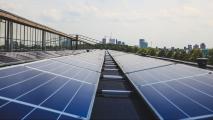Earthships are a type of off-the-grid home built from old tires and glass bottles, and interest in them is picking up as people look for ways to live more sustainably in the face of climate change.
The background: After graduating with a degree in architecture in 1969, Mike Reynolds moved from Ohio to Taos, New Mexico, where he started experimenting with ways to solve two perennial problems simultaneously: too much trash and not enough affordable housing.
“They were talking about a freak on the mesa in New Mexico building buildings out of garbage,” Reynolds told the Washington Post of initial reactions to his efforts. “That was scandalous.”
“They’re super inspiring from a sustainability point of view.”
Trent Wolbe
Reynolds eventually landed on a style of building he dubbed an “Earthship,” and while each one is unique, they’re all designed to rely heavily on recycled materials and natural resources.
The walls of Earthships are typically made from dirt-filled rubber tires covered in concrete. The buildings rely on solar and wind power, have built-in rainwater collection and filtration systems, and include greenhouses that can typically produce 20% to 50% of a resident’s food.
The Earthship era: The design did catch on with people interested in off-grid living, but according to the WaPo article, many early Earthships would sit unoccupied for years.
Now, with climate change putting sustainability at the forefront of many people’s minds, interest in Earthships is growing, and Reynold’s construction company, Earthship Biotecture, is now selling some homes before it even finishes building them.
In addition to constructing new Earthships, Reynold’s company also runs an academy where people can pay $1,000 to learn how to build and maintain Earthships themselves.
The big picture: Earthships aren’t for everyone. They take significant effort to build and maintain, and some people simply might not like the look of the structures. They can also be incredibly expensive to construct (though energy and food savings help offset the cost).
However, the increased interest in the unique buildings is a positive sign that the dream of a solarpunk future could still become a reality.
“They’re super inspiring from a sustainability point of view,” Earthship owner Trent Wolbe told WaPo. “If you’re a builder, or someone who is interested in doing off-grid systems and expanding where people can live reliably, then all signs point to Earthships.”
We’d love to hear from you! If you have a comment about this article or if you have a tip for a future Freethink story, please email us at tips@freethink.com.






